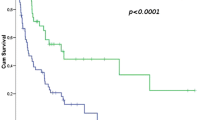Heading
Abstract
Purpose. For high-risk soft tissue sarcoma (HR-STS) of adults new treatment strategies are needed to improve outcome with regard to local control and overall survival. Therefore, systemic chemotherapy has been integrated either after (adjuvant) or before (neoadjuvant) optimal local treatment by surgery and radiotherapy in HR-STS.
Methods and results. The Soft Tissue and Bone Sarcoma Group (STBSG) of the European Organization for Research and Treatment of Cancer (EORTC) is conducting an open randomized trial of adjuvant chemotherapy in high-grade primary or recurrent STS at any site (EORTC 62931). In all cases primary surgery should be curative in intent. All eligible patients are randomized after completion of definitive surgery to receive either radiotherapy alone with no further treatment (observation arm) or five cycles of doxorubicin (70 mg/m2) plus ifosfamide (5 g/m2) using G-CSF to support dose intensity followed by radiotherapy (chemotherapy arm). This more aggressive chemotherapy regimen within an adjuvant setting might retain sufficient antitumor activity to convert response rates into survival benefit. At present more than 220 patients have been recruited for this trial. To explain the rationale for the EORTC 62931 protocol, reported results of other clinical adjuvant protocols including a meta-analysis are given. In close collaboration with the European Society of Hyperthermic Oncology (ESHO) the STBSG has also initiated a randomized trial of neoadjuvant chemotherapy in primary or recurrent HR-STS as an EORTC Intergroup study. According to the inclusion criteria as defined (tumor size ≥5 cm + grade II or III + deep location + extracompartmental extension) for the EORTC 62961/ESHO RHT-95 Intergroup study, the majority of patients with HR-STS recruited for this pre- and postoperative multimodality treatment protocol cannot be cured by standard procedures. All eligible patients are randomized to receive either four cycles of EIA (etoposide 250 mg/m2 + ifosfamide 6 g/m2 + doxorubicin 50 mg/m2) within 12 weeks (chemotherapy arm) or the same EIA regimen combined with regional hyperthermia (RHT + chemotherapy arm). The patients then receive optimal local treatment using adequate surgery immediately followed by radiotherapy. Thereafter an additional four cycles of EIA chemotherapy are given with or without RHT according to the initial randomization. At present more than 150 patients have been recruited for this trial. The integration of RHT as a new potent treatment modality if combined with EIA chemotherapy as first-line treatment for well-defined risk groups is based upon encouraging long-term results of phase II studies both in pretreated patients with HR-STS and in those with locally advanced disease.
Conclusions. In summary, significant prognostic variables recognized for patients with STS have been addressed in the design of two open phase III clinical trials on adjuvant and neoadjuvant chemotherapy. The best chance for offering such treatment strategies following evidence-based medicine criteria to eligible patients with HR-STS depends upon early contact with the coordinator of the individual protocol prior to any treatment.
Similar content being viewed by others
Author information
Authors and Affiliations
Additional information
Electronic Publication
Rights and permissions
About this article
Cite this article
Issels, .R., Schlemmer, .M. Current trials and new aspects in soft tissue sarcoma of adults. Cancer Chemother Pharmacol 49 (Suppl 1), 4–8 (2002). https://doi.org/10.1007/s00280-002-0445-3
Issue Date:
DOI: https://doi.org/10.1007/s00280-002-0445-3



